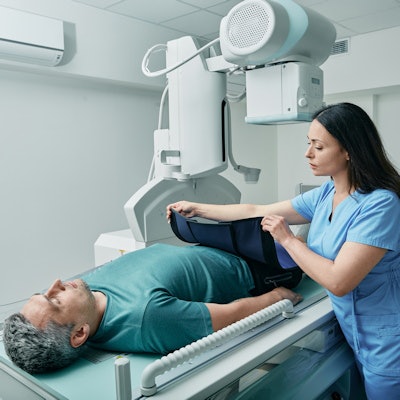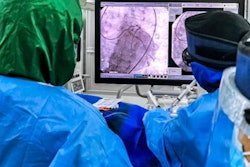
Implementation of a nonshielding policy in radiology departments is proving extremely difficult, and it will require a strong commitment by professional societies to educate and inform practitioners, patients, and carers, a European survey has found.
Contact shielding of patients is still widely used in most radiology departments, particularly in conventional radiography, where the most frequently shielded organs are the gonads, followed by the thyroid, female breasts, and eye lens -- despite increasing evidence that the practice is not useful in many cases, according to a poll of members of the European Society of Radiology and European Society of Pediatric Radiology.
"The survey is an important next step in advocating for change in clinical practices and is another example of the theory-practice divide, where practice may often lag behind theoretical developments based on new evidence and guidance," Shane Foley, PhD, associate professor and head of radiography at University College Dublin, told AuntMinnieEurope.com.
This was entirely expected, especially given the longstanding practice of shielding use, which has been widely taught and implemented as a key step in radiation dose optimization since the 1950s. "It takes time to change habits," added Foley, who is a co-author of the survey published on 19 June in Insights into Imaging.
What were the key findings?
The survey took place between 15 May and 15 September 2021. A total of 225 centers from 35 countries responded to web-based questionnaire, which consisted of 59 questions.
Contact shielding was routinely applied in at least one imaging modality in 49.2% of centers performing studies in adults, 57.5% of centers performing studies in children, and 47.8% of centers performing studies on pregnant women.
In conventional radiography, 36.7% of respondents said they routinely used in-field shielding in adults, and the figure was 40.9% in children. In CT, 18.2% of respondents routinely used shielding in adults, while the figure was 19.5% in children.
In centers performing interventional radiology procedures, 30% routinely used shielding in adults, and 25.3% did so in children. In dental imaging, 27.7% of respondent routinely used shielding in adults, compared with 31.1% in children.
Of the 119 centres that performed mammography exams, 29 centers used shielding. The most shielded organs were gonads (21.8%), thyroid (11.8%), and eye lens (3.4%). Also, of the 113 centers that performed radiologic imaging in pregnant women, 54 (47.8%) used shielding of the fetus; the most common studies in which shielding was used were chest radiography (44.2%), chest CT (38.1%), and extremity radiography (36.3%).
| Questions for all participating centers about the challenges when discontinuing the practice of contact shielding in daily practice. Percentages refer to the total number of centers. | ||
| All centers | Number (out of 225) | Percentage |
| When discontinuing the practice of shielding of patients in daily practice, what would be or what were the main challenges for implementation (tick all that apply)? | ||
| Psychological aspects/expectations of parents/carers | 127 | 56.4% |
| Psychological aspects/expectations of patients | 111 | 49.3% |
| Convincing imaging staff of the marginal benefits/risks of shielding | 95 | 42.2% |
| Lack of consistent messaging on the topic | 70 | 31.1% |
| Personal education – I don't fully understand why we should stop shielding and am not confident enough to inform others about the topic | 66 | 29.3% |
| Did a patient/parent/caretaker complain if shielding was not used? | ||
| Yes | 85 | 37.7% |
| No, even though we do not use contact shielding routinely | 56 | 24.9% |
| I don't know | 44 | 19.6% |
| No, because we routinely use contact shielding | 40 | 17.8% |
"Psychological aspects in patients and carers, skepticism regarding the limited benefits of contact shielding, poor knowledge and lack of consistent information appears to be the most important obstacles to the application of a no-shielding policy," noted lead author Dr. Claudio Granata, a pediatric radiologist at IRCCS Burlo Garofolo in Trieste, Italy, and colleagues.
Most departments could adopt a no-shielding policy if European professional societies provided recommendations. Significantly, 83.6% survey respondents said they would follow European recommendations on the use of shielding when provided by the main European bodies involved in radiology, they added.
Looking to the future
Foley hopes the results of the survey will further highlight the rationale for change and help to harmonize practices across Europe and beyond by focusing radiation protection efforts on more impactful approaches such as x-ray beam limitation and indication-based optimization.
"There is a feeling that the current situation is slowly changing, and it certainly feels like there is less resistance or hesitancy with the new guidance, as more and more discussions are being had and evidence debated -- which can only be a good thing," he said. "This certainly has to continue as we cannot think practices will change simply by publishing new guidance or research articles; we really have to intentionally involve stakeholders and listen to their perspectives and important considerations."
An important driver for shielding use is patient/carer expectations. "To keep momentum building, we really have to improve our engagement with patients/carers and ensure information is communicated to this our key audience," Foley continued.
The work of the Gonad and Patient Shielding (GAPS) Group, which involved a patient representative in producing the European consensus document, showed how patients are very understanding of practice changes, provided they are informed adequately about these measures, he noted.
The authors now plan to continue the dissemination and engagement work that the GAPS Group has started and continue to build the scientific evidence, such as showing exactly how beneficial practices such as collimation and radiographic technique are in comparison to shielding.



















